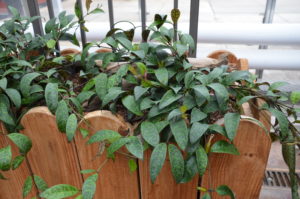Nothing brightens up a room more than a flowering plant. One of my favorites is lipstick plant or lipstick vine (Aeschynanthus spp.), a close relative of the African violet. The green leaf form A. radicans is very popular with shiny dark green leaves and orange, pink, purple flowering varieties.
Lipstick plant is a free bloomer, meaning that flowering is tied to how much light, humidity, temperature and fertility the plant is receiving. It produces with colorful flowers that emerge from dark buds like a tube of lipstick near the tips of the branches.
Proper care will reward you with good flowering. Lipstick plant enjoys a humus-rich potting mix (one designated for house plants) and good feeding program. Most house plant fertilizers manufactured by Schultz™, Miracle-Gro™, Jack’s™, and others are ideal. Feed lipstick plant every 2-3 weeks in spring, summer, and early autumn @ one-half the package rate. Autumn to winter feeding should be monthly as the plant undergoes a brief rest period.
Water the plant thoroughly and allow soil (media) to dry partially before re-watering the plant. Overwatering is a huge mistake. Lipstick vine will not bloom unless in a brightly lit room. Too much direct sunlight may burn the foliage. Room temperature should be around 68 to 80 °F. (20-27 °C.) for best flowering. This tropical plant may be injured at temps lower than 50 °F (10 °C).
A hanging basket is the perfect pot for growing a lipstick vine. Repot the plant annually, preferably in late winter. Mealy bugs, spider mites, aphids and white flies may be occasional pests. Safe organic pesticides like insecticide soap or neem oil will handle most pests.
Groom (prune back) long vines after flowering as needed. In late winter revitalize the plant by pruning it back by one-third to encourage new branching and re-blooming.
Over the winter heating season, maintain a room humidity around 40 – 50% by daily misting or run a room humidifier.


 Posted in
Posted in 
